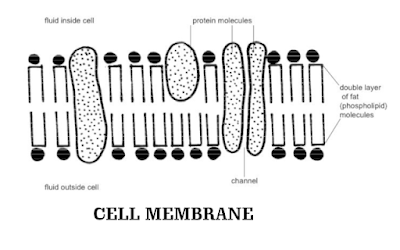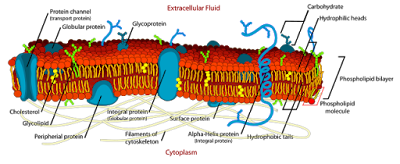Cell Membrane - Structure and Functions
Class 9 - Biology - Cell: Fundamental Unit Of Life
 |
| Plasma Membrane Diagram Image Credits: Ruth Lawson. Otago Polytechnic Wikimedia |
Structure:
- Cell membrane is also called as plasma membrane or plasma lemma.
- It is the limiting boundary of each cell which separates the cytoplasm from its surroundings.
- It is found in both plant as well as animal cells.
- It is the outermost covering of a cell in case of animals and lies below the cell wall in case of plants.
- It is made up of proteins and lipids where proteins are sandwiched between bilayer of lipids.
- Plasma membrane is selectively permeable in nature. It allows or permits the entry and exit of some materials in and out of the cell.
- Singer and Nicholson gave the fluid mosaic model of plasma membrane. According to them, it consists of a protein layer sandwiched between two layers of lipids.
- It is in quasifluid state. It is 75A thick.
- It is flexible and can be folded, broken and reunited.
- It is the living component of the cell.
 |
| Credits: Mariana Ruiz (edited by AlokPrasad) Wikimedia |
Functions:
- It selectively regulates the entry and exit of substances into and out of the cell. That's why it is called selectively permeable or semi-permeable.
- It provides an outer boundary to the cell and protects cell from injury.
- Provide organic connections among adjacent cells.
- Maintains distinct composition of the cell.
☛See also:
Ch 5 - Fundamental Unit of Life (Q & A)
Ch5 - Fundamental Unit of Life (MCQs)
Ch5 - Fundamental Unit Of Life (Question Bank)
Ch5 - Fundamental Unit Of Life - Quiz On Cell Organelles
Ch 5 - Interactive Cell - Play to learn about cell organelles
Ch5 - Fundamental Unit of Life (Worksheet)
Ch5 - 7 Points About Plasmolysis
Ch5 - Cell - Very Short Answer Based Questions (Set-1)
Ch5 - Fundamental Unit of Life (MCQs)
Ch5 - Fundamental Unit Of Life (Question Bank)
Ch5 - Fundamental Unit Of Life - Quiz On Cell Organelles
Ch 5 - Interactive Cell - Play to learn about cell organelles
Ch5 - Fundamental Unit of Life (Worksheet)
Ch5 - 7 Points About Plasmolysis
Ch5 - Cell - Very Short Answer Based Questions (Set-1)
No comments:
Post a Comment
We love to hear your thoughts about this post!
Note: only a member of this blog may post a comment.